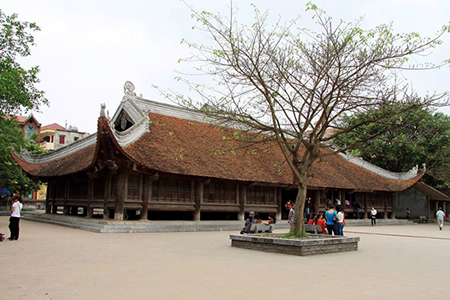The communal house of Dinh Bang village (Tu Son district, Bac Ninh province) is the most well-known of the surviving communal houses in the region.
The communal house of Dinh Bang village (Tu Son district, Bac Ninh province) is the most well-known of the surviving communal houses in the region.
The construction began in 1736, during the reign of King Le Y Tong, and was completed after dozens of years of continued labour. It was originally dedicated to the cult of three village tutelary Gods: the Earth God, the Water God and the Cultivation God. It was also dedicated to 6 founders of the village who lived the 15th century. When the Ly Bat De temple was ruined by war, the villagers of Dinh Bang moved the worshipping tablets of 8 Kings of the Ly dynasty to this communal house.

The communal house is located on a high ground and faces the south. It was surrounded by 17 lakes – which were the remains of the Tien Luong (or Tieu Thong) river, a canal which was linked to the Duong River and served as a convenient water way for the Kings of the Ly dynasty to come to visit the area from Thang Long, the then royal capital. Yet only a small lake in front of the communal house still exists.
Long ago, it had a three-entrance gate with a left wing and a right wing; due to wars, it has been destroyed; there now remain only the Hall of Ceremonies and a corridor leading to the Inner Room. The general lay-out evokes the Chinese character “cong” . The Hall of Ceremonies is 20 metes long, 14 metes large and comprises seven smaller compartments and two wings. Its elevated floor is covered with blue stones and stairs. The height from the floor to the roof is about 8 metes, but the roof and its curved ends make up 2/3 of the height of the house. The roof is supported by 60 ironwood columns and a framework of valuable wood, which are elaborately sculptured with common images; in particular, the dragon figures number about 500. Sliding doors are fixed on four sides of the Hall of Ceremonies for the purpose of ventilation. The floor of the hall is elevated by 0.70m with wooden girders, beams and boards, and as a result, the whole structure looks somewhat like a stilt house of the ancient Vietnamese. Thanks to tenons and mortises, which link various components of its framework, the house is quite solid.
Two big ceremonies are usually held every year in the communal house of Dinh Bang: the traditional festival on February 12 (Lunar Calendar); and the festival in commemoration of the establishment of the Ly dynasty on March 15 (Lunar Calendar).



